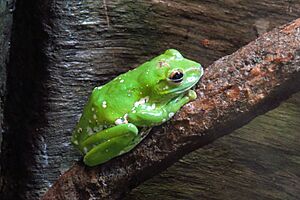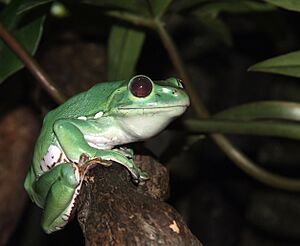Chinese flying frog facts for kids
Quick facts for kids Chinese flying frog |
|
|---|---|
 |
|
| Conservation status | |
| Scientific classification | |
| Synonyms | |
|
The Chinese flying frog or Chinese gliding frog (Zhangixalus dennysi) is a cool type of tree frog. It belongs to the family called Rhacophoridae. You can find this amazing frog in countries like China, Laos, Myanmar (Burma), and Vietnam. People sometimes call it Blanford's whipping frog or Denny's whipping frog too.
Contents
Meet the Chinese Gliding Frog!
This special frog can grow quite large. It can be up to about 10 cm (3.9 in) long. That's roughly the length of a smartphone! One of the most interesting things about this frog is its super loud call. Imagine a frog that can really make itself heard!
Where Do They Live?
Chinese gliding frogs love to live in wet forests. You can find them in lowlands, on mountains, and on hills. They usually stay close to streams. These frogs prefer "primary forests," which are old forests that haven't been changed much by people. They have been seen living at different heights. This can be from about 80 meters (260 feet) up to 1500 meters (almost a mile high!) above sea level.
How Do They Have Babies?
Female Chinese gliding frogs lay their eggs in special foam nests. They attach these nests to branches and grasses that hang over water. How do they make these nests? They beat a foamy liquid into a bubbly foam using their back legs!
The baby frogs, called tadpoles, then grow in different watery places. These can be:
- Paddy fields (fields where rice is grown)
- Holes full of water
- Ponds
- Marshes
Is the Chinese Gliding Frog Safe?
The IUCN (International Union for Conservation of Nature) says this frog is of "Least Concern." This means it's not in immediate danger of disappearing. However, there are still some challenges for these frogs.
What Dangers Do They Face?
The biggest danger comes from habitat loss. This means their forest homes are shrinking.
- People sometimes go into the forest to take things they need.
- Forests are sometimes changed into small farms.
- Pollution can harm the frogs and their water.
- Wildfires can destroy their homes.
- Changes in how water flows (hydrology) can also hurt them.
In some places, people also catch these frogs. They might be caught to be eaten. Or they might be sold as pets to people in other countries.
The good news is that some of the places where these frogs live are protected parks. These parks help keep their homes safe.



